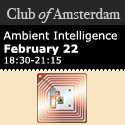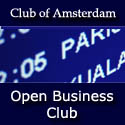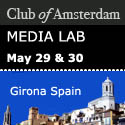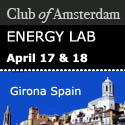
Content
Welcome to the Club of Amsterdam Journal. “Ambient Intelligence allows Information Society services to be available to anyone, anywhere, using a variety of devices. The vision is an Information Society which is much more user-friendly, more efficient, empowers users and supports human interactions. People will be surrounded by easy-to-use interfaces embedded into all kinds of objects and by an everyday environment that is capable of recognising and responding to individuals in a seamless, unobtrusive and invisible way.” – EU Information Society Technologies Join our discussion about the future of Ambient Intelligence on February 22 |
Changing lives for the better
Ambient Intelligence by Philips Research – Technologies
This year (2003), Philips’ vision of ambient intelligence reached its fourth birthday. it is the vision of a world in which technology, in the form of small but powerful silicon chips, will be integrated into almost everything around us, from where it will create an environment that is sensitive to the presence of people and responsive to their needs. an ambient intelligence environment will be capable of greeting us when we get home, of judging our mood and adjusting our environment to reflect it or soothe it. such an environment is still a vision, but it is one that has already struck a chord in the minds of researchers around the world and become the subject of several major industry initiatives. one such initiative that has already paid valuable dividends is Philips’ homelab – a test bed for ambient intelligence that is more like a real home than a laboratory.
Gaining momentum
The vision of Ambient Intelligence first proposed by Philips Research back in 1999 is now, in some shape or form, a significant part of scientific research around the world. It has been an important theme in Philips Research’s collaboration with the Massachusetts Institute of Technology (MIT), in particular in MIT’s Oxygen project, which is developing technology for the computer of the 21st century. Another alliance with INRIA and Thomson Multimedia has resulted in the initiation of a special project called Ambient Intelligence Research and Development, which is developing software platforms for Ambient Intelligence applications in the home.
In addition to these initiatives, Ambient Intelligence has also won significant financial backing from the European Union. During a series of workshops organized by the Information Society and Technology Advisory Group (ISTAG), which serves as an influential advisory board to the European Union, Philips’ vision of Ambient Intelligence was adopted in 2001 as the leading theme for the Sixth Framework on IST Research in Europe. This will result in a European research programme, with a budget of 3.7 billion Euros over the coming four years and dedicated to the topic.
Philips’ own commitment to Ambient Intelligence is typified by its investment in HomeLab – a home that is also a laboratory, not a laboratory that is also a home. HomeLab has real living spaces in which the technology is as well hidden from view as it will be when Ambient Intelligence comes to us all, and several Philips Research establishments throughout the world currently contribute to the programmes that run there.
Many of the identifiable characteristics of Ambient Intelligence and the technological solutions that have been developed in HomeLab and other parts of Philips Research to implement them you will find discussed elsewhere in this issue of Password. Ultimately however, Ambient Intelligence is not about technology but about people, because it is not Ambient Intelligence that will shape the future of ordinary people, it is ordinary people who will shape the future of Ambient Intelligence – by making decisions on how they want their lives to be changed. Some of the most vital research in HomeLab is therefore aimed at gaining important psychological clues as to what those decisions might be.
Privacy and trust
In the same way that HomeLab is as close as possible to a real home, the human guinea pigs that are selected to live in it are as close as possible to ordinary people. They are selected from members of the general public by an independent selection agency, the only criteria being that they fit certain profile parameters such as age and interests.
Not surprisingly, when these people first enter HomeLab they are highly inquisitive about the environment. Although they are aware that it is a technologically advanced home, technology in the form they have been used to is nowhere to be seen. Instead of conventional TV sets, for example, there are merely screens with none of the usual controls.
A typical first response is to seek out the technology, up-ending chairs and other items of furniture in the belief that they will find technology in everything. While some of this inquisitiveness is probably due to natural curiosity, it is also based in a deep-rooted mistrust of a technology that they know must continuously monitor their activities in order to do its job properly. Thoughts of George Orwell’s ‘1984’ are probably not too far from their minds.
In practice, this issue of trust (or mistrust) is one of the main areas of concern for scientists at Philips Research and it is why HomeLab project teams typically include one or more experimental psychologists as well as engineers and scientists. With its firm commitment to improving the quality of people’s lives, Philips is only too aware that no matter how advanced its technology and how exciting the scenarios in which it is used, people will not accept it if they do not trust it. The results of its research so far have shown that simply giving consumers access to and control over the data that the system collects about them is often sufficient to allay there fears, even if they do not choose to exercise that ability.
This question of trust is closely linked to another social issue that is addressed in HomeLab – namely the issue of privacy. For a long time, video telephony has been hailed as one of the next killer applications for the connected home, but nearly always in the context of the way existing voice calls are made – the phone rings and you choose whether or not to answer it. In an Ambient Intelligence environment, however, one of the main applications for such links is seen as creating a continuous feeling of togetherness so that you can share specific experiences or everyday living with friends and relations who are physically separated from you.
Experiments in HomeLab have shown that ‘full-motion’ video links that show every movement and facial expression of each group member can actually be quite disturbing, because participants have the uneasy feeling of being watched. A better feeling of togetherness was created when the visual information available from remote sites was limited to a sketch-like outline of each person. This is a typical example of how experiments within HomeLab have proven that intuitive solutions are not always the correct ones.
Researchers in HomeLab have also investigated ways in which this feeling of togetherness can be engendered as a continuous background task rather than being confined to specific activities such as watching a football match together. When you live with people in the same house, you pick up a lot of contextual clues about who is at home and what they are doing – for example, the shoes that you see in the hallway when you arrive home, the sound of running water in the bathroom or the smell of cooking from the kitchen.
Philips Research is therefore looking at ways in which some of this contextual information can be communicated between homes in a way that does not intrude on individual privacy. One idea is that the level of activity on utility feeds such as gas, water and electricity could be monitored and transmitted to the homes of friends or family members in order to provide such clues.
A key advantage of HomeLab is that it is a fully working home as well as a laboratory, which means that participants can easily live in it continuously for several days. This has two important advantages. Firstly, it gives them time to forget that they are being observed, not only by the sensors that are built into the Ambient Intelligence systems but also by Philips’ researchers from behind one-way mirrors. Secondly, it allows them to become familiar with the environment and to settle down into daily routines that closely resemble those that apply in their own homes.
This second phase, when participants have overcome the wow-factor and become oblivious to the cameras, is the one that yields the results Philips Research is looking for. During this time, the activities, postures, facial expressions and the social and user-system interactions of participants are all recorded so that they can be analysed to identify system improvements and new applications.
After more than a year in which several projects have run in HomeLab, several important facts have already come to light. Once people realize the benefits of new technology, they begin to trust it. Once they trust it, they become comfortable with it. And once they become comfortable with it, it changes their lives.
A culture of cooperation
For those fortunate enough to have been human guinea pigs in Philips’ HomeLab, Ambient Intelligence will have already changed their lives, if only for a few short hours or days. Given a glimpse of what the future might look like, it is highly probable that in some small way it will have altered their perspective on technology forever. However, it is not only the lives of HomeLab’s guinea pigs that Ambient Intelligence has already affected. It has also changed the lives of a large number of people within Philips.
For practical reasons of human communication and cooperation, large companies such as Philips, are actually made up of many small companies, each with its own business plan, product development roadmap and marketing strategy. Truly successful companies are the ones that can unite these component companies into a common goal.
When you look at the current structure of Philips, which has now been in place for the best part of two decades, it is clear that its separate divisions all operate with the common goal of improving the quality of people’s lives. Its Consumer Electronics division is committed to improving the quality of our leisure experiences, its Medical Systems division to improving our state of health, and its Lighting and Domestic Appliances & Personal Care divisions to extending the hours available to us for enjoyment. Stemming from the very top ranks of Philips, an initiative called TOP (Transforming into One Philips) has already been put in place to leverage synergies between these divisions to create new product concepts and user experiences.
In the world of Ambient Intelligence few things operate stand-alone. Lighting, sound, vision, domestic-appliance and personal-healthcare products all play a part in creating a total environment that is sensitive and responsive to the presence of people. Ambient Intelligence therefore fits extremely well into the TOP programme, helping to spread a culture of communication and cooperation throughout the entire company. Such cooperation was the source of “The New Everyday”, a 350-page comprehensive book on all aspects of Ambient Intelligence, published jointly by Philips Research and Philips Design.
LAB on Old and New ENERGY in Spain
| LAB on Old and New ENERGY An immersed experience of a Do-Tank April 17 & 18, 2007 Location: Girona near Barcelona, SpainMax. 20 DelegatesPlease use our Energy LAB registration Moderated by Humberto Schwab, Director, Club of Amsterdam, Innovation Philosopher and the Thought Leaders Nathalie Horbach, Centre for Energy, Petroleum and Mineral Law and Policy, University of Dundee Nuclear policies specialist Simon Taylor, Director and Co-Founder, Global Witness Environmental issues Christof van Agt, International Energy Agency Sustainable energy specialist Paul Holister, Nanotechnology & Energy |
News about the future of Ambient Intelligence

Airport Security
The plan is to issue an RFID (radio frequency identification) tag to every passenger at check-in so human traffic can be monitored throughout the airport via transponders and video cameras.
Paul Brennan, an electrical engineer at University College London, heads the project, which features an RFID technology called Optag. Funded by the European Union, the technology is being developed by a consortium of European companies and the university.
Brennan said Optag has been designed to improve airport security by virtue of its ability to track the movement of suspicious passengers, which would enable security personnel to bar them from entering restricted areas.

amBX – a new way of experiencing home entertainment
“amBX is shorthand for ‘ambient experiences’. Driving the next generation of home entertainment, it’s a scripting language, a software engine and architecture.
With amBX, multiple devices in your room work in harmony to deliver new entertainment experiences: surround lighting, sound, vibration, air movement and other effects. It takes what’s pretty much a ‘virtual’ activity – games, DVDs, music – and turns it into a far more tangible, immersive experience.
The applications of amBX are only limited by the imagination and creativity of content creators and, ultimately, end users. Just imagine ambient room lighting and other changes tied-in to your favourite music, to web content, interactive toys and games, books, or even to reflect the time of day and your changing moods? “
Club of Amsterdam blog
 | Club of Amsterdam blog February 12: Innovation – a hybrid connection between old practices? January 8: The Future of Consciousness December 18: selflead December 14: On the Art of Value-Webbing |
News about the Future

The Museum of Modern Betas
The MoMB is a site dedicated to listing webbased applications on a beta trip.Saurier Duval, the man behind the Museum of Modern Betas (MOMB): “Currently I update entries if a site goes from private to public beta, out of beta, shuts down and so on, and there is a dedicated section for sites which went out of beta. There was a section for sites which no longer exist a while ago, but I removed it ’cause it felt a bit like enjoying someone elses failure and I didn’t like that.”

A clear view with transparent coatings
Fogged-up windshields will soon be a thing of the past: A new lacquer will ensure better visibility in tomorrow’s cars. The electrically conductive coating uses nanotechnology to heat the windshield across its entire surface – with no wires to obstruct the view.
On cold winter mornings, a driver’s vision is often blurred by moisture precipitating on the inside of the windshield. This happens when warm, humid air comes into contact with a cold surface. At a particular temperature, known as the dew point, the moisture in the air condenses and forms a layer on the colder surface; irrespective of whether this is a glass containing a cold drink, the bathroom mirror after a shower, or the windshield of a cold car. Cold air is not able to contain as much moisture as warm air and this fact is much more noticeable in small spaces, in a car for example. Condensation can be prevented by increasing the volume of air (opening the windows), by heating the whole of the vehicle’s interior, or by heating at least the windshield to a temperature above the dew point.
Ivica Kolaric of the Fraunhofer Technology Development Group TEG in Stuttgart favors the third option. His new process warms up the windscreen – though not with costly copper heating elements, but instead with a transparent coat of carbon lacquer, or more exactly carbon nano tubes (CNT). Kolaric and his team are currently working on a bonding system which, in a year or two from now, could keep not only windshields but also bathroom mirrors free from condensation
LAB on MEDIA and Human Experience in Spain
| LAB on MEDIA and Human Experience An immersed experience of a Do-TankMay 29 & 30, 2007 Location: Girona, Spain Max. 20 Delegates The underlying question is: “What is the meaning of media innovation on the quality of the human experience?” If we talk about human experience we mean the inner- and outer experience. So cognitive technology knowledge, related fields of neuroscience and anthropology are essential in these matters.We start from the knowledge we have about brain and computer games, television and our psychological state, Internet and communications, identity and images. We use the experience we have with the relation between media and mobility, learning, politics, power etc.Given the ubiquity of media, the change to read and write media, the nano-technology revolution and the open source movement: we have to determine the burning questions. With different brainstorm tools we will innovate al these concepts so we can integrate these new hybrids and innovations in strong human oriented meanings and human values. Moderated by Humberto Schwab, Director, Club of Amsterdam, Innovation Philosopher With the Thought Leaders Laurence Desarzens, urban communicator, beatmap.com Paul F.M.J. Verschure, ICREA research professor, Technology Department, University Pompeu Fabra Ricardo Baeza-Yates, Director, Yahoo! Research Rudy de Waele, Founder, M-trends.org www.clubofamsterdam.com |
Market Overview – Ambient Intelligence
A research by Frost & Sullivan
Focused Research Efforts Necessary to Take Ambient Intelligence toward Commercialization
Ambient intelligence combines ubiquitous computing, interfaces and communications to take interaction between users and devices to a much more sophisticated level. The goal is to develop a network of intelligent devices that is pervasive and unobtrusive to cooperatively gather, process, and transport information across various environments. Current research efforts in this field focus on key areas such as security, generic platforms for executing heterogenous applications, development of autonomous devices, agent-based computing, intelligent interfaces, and distributed architecture among others.
Since it is still in the conceptual stage, the success of ambient intelligent is dependent on a combination of factors. For example, the development of unobtrusive hardware that merges with the environment has become a vital requirement. “With the current trend of miniaturization in the electronics industry, and the advancements in nanoelectronics and nanodevices unobtrusive hardware is a definite possibility,” says the analyst of this research service. “Research is also underway to create miniature hardware that exhibits low heat dissipation, consumes less power, operates at higher speeds, and has a longer life.” Since an ambient intelligence environment would consist of a network of innumerable devices that are portable in nature there is also a need for dynamic and distributed device networks. The network should therefore support plug-and-play features to instantaneously connect devices after the initial authentication process, and identity establishment. Researchers must also work toward ensuring greater dependability and security for ambient intelligence to reach commercialization.
Interoperability and Standardization Key to Successful Implementation of Ambient Intelligence
As researchers strive towards taking ambient intelligence into the commercial market, interoperability and standardization will play a critical role. “Since ambient intelligence is built on the principle of integrating multiple devices through various communications medium and technologies, implementation becomes highly challenging,” explains the analyst. “The key is to enable users to interface with any device in a simple manner through a generic platform that connects all the devices without any technological issues.” Standardization right from the interface level to the implementation and hardware deployment is also proving to be important for integrating a pool of heterogeneous devices.
Another key accelerator for ambient intelligence is the rapid advancements in wireless communication technologies in terms of higher bandwidth and data transfer rates and low power requirements. As ambient intelligence overcomes the initial challenges and heads into commercialization, healthcare and home automation are expected to be the fastest and biggest adopters of this revolutionary technology.
[…]
Next Season Event
the future of Ambient Intelligence Thursday, February 22, 2007 Registration: 18:30-19:00, Conference: 19:00-21:15 Where: Info.nl, Sint Antoniesbreestraat 16, 1011 HB Amsterdam [Next to Nieuwmarkt] Introduction by our Moderators Ben Schouten, Lector Ambient Intelligence and Design, Fontys & CWI Rob van Kranenburg, Innovation and Media Theorist The promise of an Ambient Society Boris de Ruyter, Principal Scientist, Media Interaction Department, Philips Research Europe Promise of AI for the home (ideal home) Erik Geelhoed, Hewlett-Packard Laboratories, UK Promise of AI in mobility and mobile gaming Berry Eggen, Professor, Vice Dean, Department of Industrial Design, TU Eindhoven Promise of AI for design Klaas Kuitenbrouwer, Mediamatic Promise of AI for media Maurits Kreijveld, Challenger |




DSC00016 

Recommended Book

The New Everyday View on Ambient Intelligence
by Stefano Marzano; Emile Aarts
What is Ambient Intelligence? Is it embedding technology into objects? How does it incorporate or cater for universal desires, complex social relationships, different value systems? What about individuals’ likes and dislikes, or the sustainability of economic and natural ecosystems? This book explores the increasingly relevant phenomenon of Ambient Intelligence in the form of essays by experts with illustrations.
ASTRONET
| ASTRONET was created by a group of European funding agencies in order to establish a comprehensive long-term planning for the development of European astronomy. The objective of this effort is to consolidate and reinforce the world-leading position that European astronomy has attained at the beginning of this 21st century.Science Vision The goal is to establish a global European Science Vision for Astronomy for the next 15-20 years, based on the existing national and regional strategic plans, complemented from analysis of key scientific themes by ad-hoc panels set up by the ASTRONET Board. To establish a global European astronomical Science Vision for the next 15-20 years will be the task of the Science Vision Working Group (SVWG). The field has been divided in four broad science questions:Do we understand the extremes of the universe?How do galaxies form and evolve?How do stars and planets form?How do we fit in? From “The future of Danish Astronomy” Astronomy is unique among the natural sciences. Astronomy asks some of the deepest questions facing the human mind: How did the Universe begin, and how will it end? How did it evolve to contain galaxies, stars, planets, and humans? Do we live in a special part of the Universe? Does life exist elsewhere? Such questions have a strong and immediate appeal to the general public; astronomy programs on TV are very popular, and so are planetarium shows and public lectures. Astronomy is also exciting for school children, especially in high school (gymnasium) where about 500 students each year take special astronomy classes, and where astronomy is a popular topic also in physics and science classes. Thus, astronomy is an effective way to ignite the spark of interest of young people in the sciences, a matter of concern for governments and society throughout the world.In searching for answers to these fundamental questions, modern astro-physics is becoming a strongly interdisciplinary activity, involving all branches of physics, many ingredients from chemistry and geology, and elements from biology. Progress is intimately linked to technical advancements over a wide front, from development of new telescopes and detectors for all wavebands to supercomputers simulating the complex dynamics of astrophysical systems. In particular, new and innovative spacecraft now allow astronomers to explore the Earth’s environment and the Solar system, and to study the Universe at wavelengths (gamma- and X-rays, infrared and optical), which are disturbed or blocked by the Earth’s atmosphere.The potential for scientific breakthroughs in the coming decade is tremendous. In the Universe we routinely observe processes under physical conditions far beyond any which can be reproduced in laboratories on Earth; thus, breakthroughs in astrophysics are bound to have profound implications for physics in general. Astrophysics is thus a key player on the scientific forefront of physics, not just an incentive for recruitment to science. The full report describes the most prominent frontiers in more detail. Danish astronomy has the potential to play a prominent role in these exciting developments. Through the Danish memberships in ESO (European Southern Observatory) and ESA (European Space Agency) we have access to most of the leading observational facilities in the world. The development of a coherent international archiving system will place the best observational data worldwide at our fingertips. Denmark is well prepared for this exciting future as an active participant in ESO and ESA, and by developing the corresponding theoretical, modeling and technical capabilities. Now the time is ripe to benefit from these substantial investments. |
| Renewable Energy Technology Roadmap to 2020 |
The main characteristics of the present energy supply system in Europe are the dominating share of fossil fuels as well as the high dependence on energy imports. In the EU-25, fossil fuels contribute almost 80 % to the primary energy demand. When faced with the fact that only a few EU Member States are currently on track to meet their targets for 2010, it is of utmost importance to ensure that these existing targets for Renewable Energies are being achieved and that a framework for the future is set. This brochure shows the ambitions of the European Renewable Energy industry, while at the same time trying to make a concrete proposal for new targets. Concerning this structure it must be kept in mind that the resources of fossil and nuclear fuels are limited in principle. This might not restrict the energy supply in the short or mid term but the peak of production of, at least, conventional oil is already expected to occur in the next two to three decades, with some geologists seeing this peak occurring much sooner. An even more important problem with fossil fuels arises due to the fact that most of them need to be imported.To make energy supply more secure the EU Commission’s Green Paper, amongst others, recommends to tackle the EU’s rising dependence on imported energy through an “integrated approach – reducing demand, diversifying the EU’s energy mix with greater use of competitive, indigenous and Renewable Energy, and diversifying sources and routes of supply of imported energy”.And the Commission’s statements concerning Renewable Energies are very clear: “Action on Renewables and Energy Efficiency, besides tackling climate change, will contribute to security of energy supply and help limit the EU’s growing dependence on imported energy.” And more importantly, the Commission leaves no doubt that Europe must act urgently, because it takes many years to bring innovation in the energy sector. This is also true concerning Renewable Energies: At present the EU leads the world in promoting Renewable forms of Energy, yet this position must be reinforced.Taking the results of the recently published baseline (“business as usual”) scenario, written by Mantzos and Capros2, Renewable Energies will not meet these expectations by 2020 without further political and legal attention. They will not meet them even if they fulfilled the targets fixed by the EU for 2010. It is true that from 2025 onwards Renewables will become the most important indigenous energy source, but according to the baseline scenario by Mantzos and Capros their contribution to the total primary energy demand will only be roughly 8% in 2010, slightly more than 12% in 2020 and only 12% in 2030 far away from any target set so far. And it is also much farther away from the huge potential within Renewable Energy Sources, as well as from the capabilities of the European Renewable Energy industry, which is ready to commit to contributing a minimum 20% target in 2020 and respective sectorial targets for electricity, heating and cooling as well as biofuels for transport. To strengthen the security of supply and to contribute to the restructuring of the energy system by means of Renewable Energy, the European Union must set more ambitious long term mandatory sector targets to guarantee stability, and commitment for investment decisions.Without a major shift towards Renewable Energy Sources in combination with energy conservation and efficiency we will lose the chance of securing our energy supply system. If we take that chance now, the EU could become the most energy import independent region in the world. |
Agenda

Our Season Events for 2006/2007 are on Thursdays: |
| the future of Ambient Intelligence February 22, 2007, 18:30 – 21:15 the future of Global Workplace March 29, 2007, 18:30 – 21:15 the future of Success April 26, 2007, 18:30 – 21:15 the future of Tourism May 31, 2007, 18:30 – 21:15 Taste of Diversity June 28, 2007, 18:30 – 21:15 |
 |

2-days LABs in Girona, Spain, moderated by Humberto Schwab: LAB on Old and New ENERGY, April 17/18, 2007 LAB on MEDIA and Human Experience, May 29/30, 2007 |
Club of Amsterdam Open Business Club
 | Club of Amsterdam Open Business Club Are you interested in networking, sharing visions, ideas about your future, the future of your industry, society, discussing issues, which are relevant for yourself as well as for the ‘global’ community? The future starts now – join our online platform … |
















Customer Reviews
Thanks for submitting your comment!